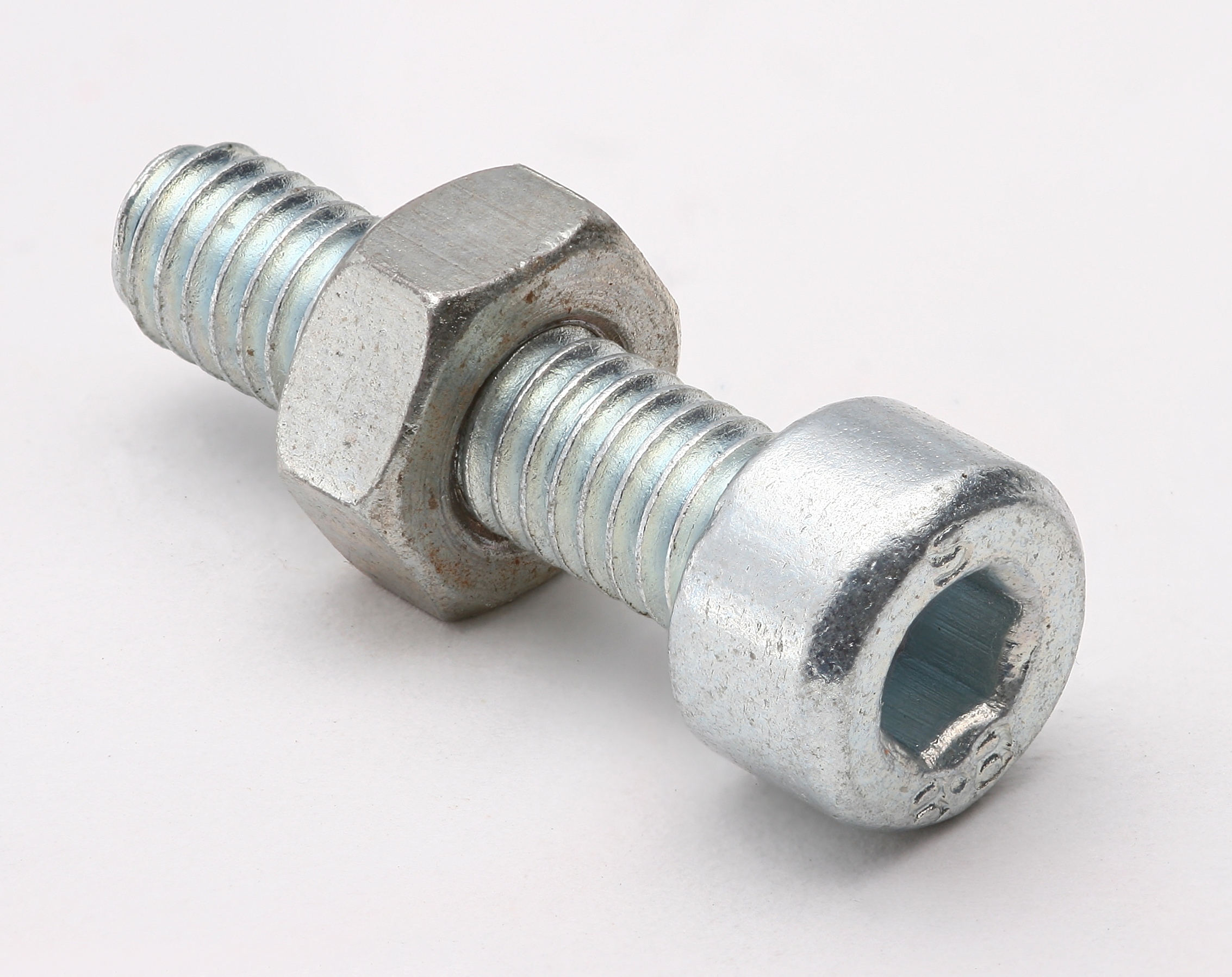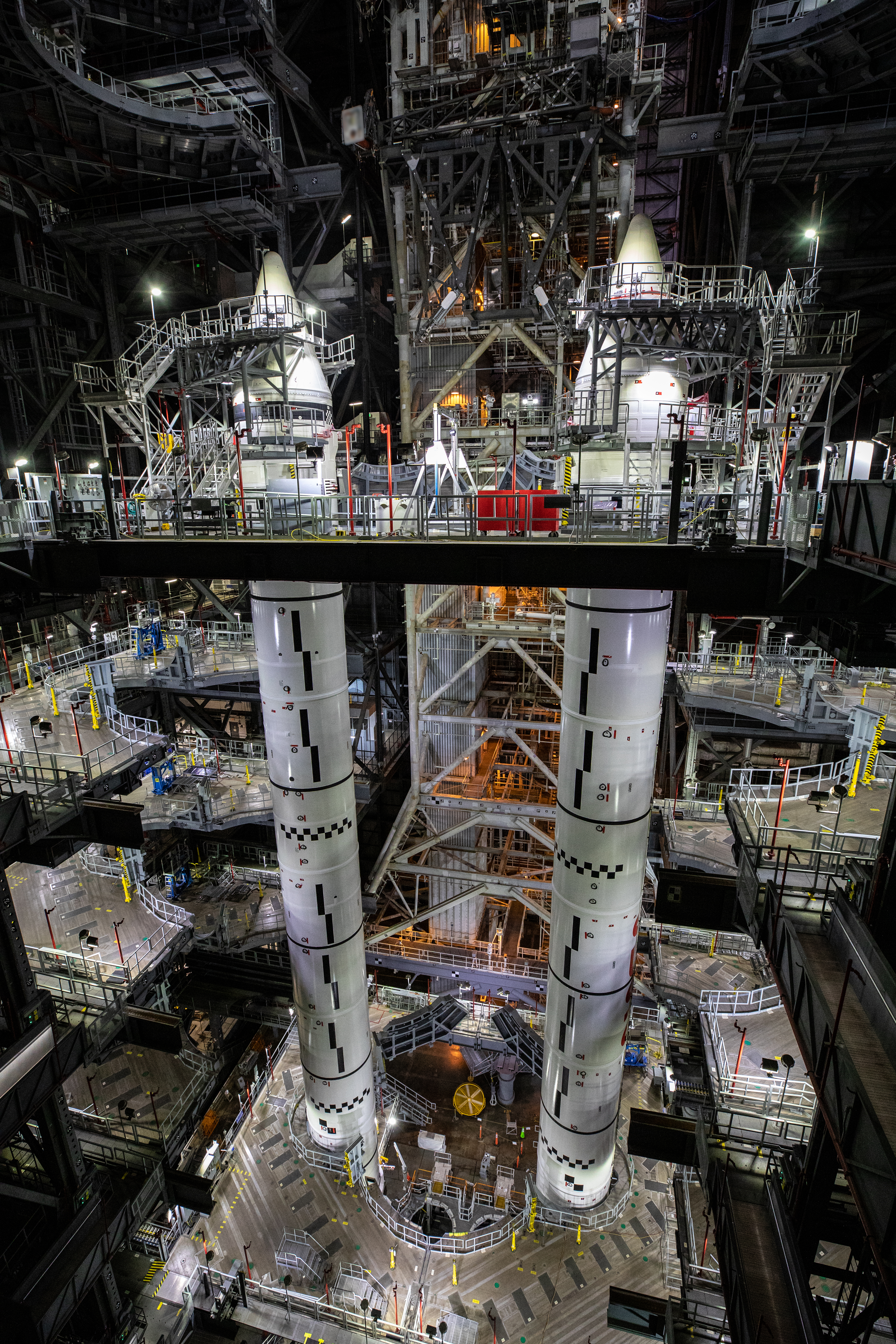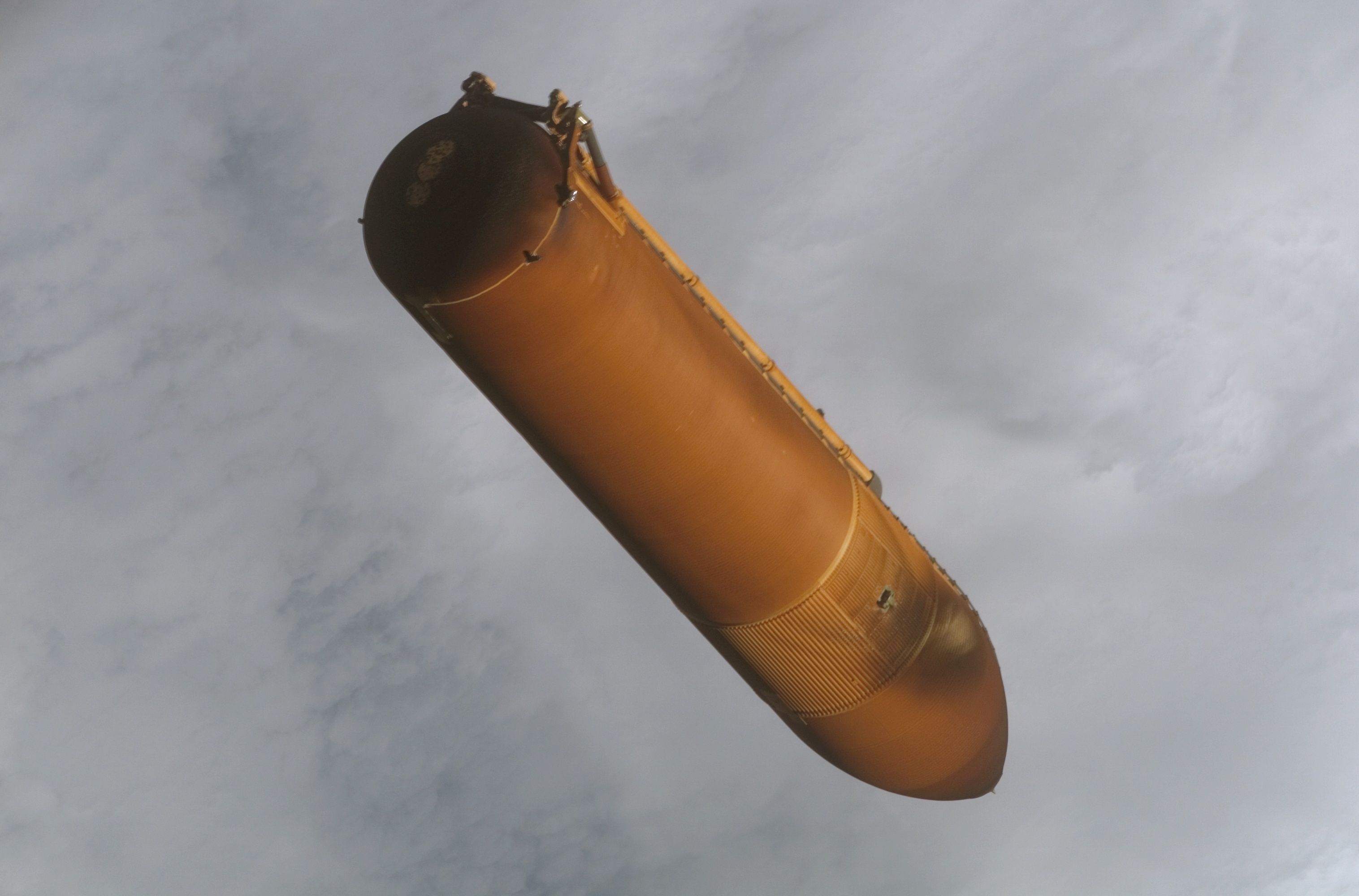|
Frangible Nut
The frangible nut is a component used in many industries, but most commonly by NASA, to sever mechanical connections. It is, by definition, an explosively-splittable nut. The bolt remains intact while the nut itself is split into two or more parts. Space Shuttle Frangible nuts secured the solid rocket boosters (SRB) of the Space Shuttle, which were bolted to the mobile launcher platform (MLP) until liftoff. On the Shuttle, they were separated using a NASA standard detonator (NSD). The space shuttle used two NSDs for the frangible nut atop each of the four , bolts holding each SRB to the MLP. Once detonation occurred, the shuttle lifted free of the MLP. The broken nut and any fragments from detonation was captured by energy absorption material, such as metal foam, to prevent damage to the shuttle. In case of NSD failure, or incomplete clearance of the nut from the bolt, the SRB had ample thrust to break the bolt itself and launch unhindered. Frangible nuts were also used for s ... [...More Info...] [...Related Items...] OR: [Wikipedia] [Google] [Baidu] |
NASA
The National Aeronautics and Space Administration (NASA ) is an independent agency of the US federal government responsible for the civil space program, aeronautics research, and space research. NASA was established in 1958, succeeding the National Advisory Committee for Aeronautics (NACA), to give the U.S. space development effort a distinctly civilian orientation, emphasizing peaceful applications in space science. NASA has since led most American space exploration, including Project Mercury, Project Gemini, the 1968-1972 Apollo Moon landing missions, the Skylab space station, and the Space Shuttle. NASA supports the International Space Station and oversees the development of the Orion spacecraft and the Space Launch System for the crewed lunar Artemis program, Commercial Crew spacecraft, and the planned Lunar Gateway space station. The agency is also responsible for the Launch Services Program, which provides oversight of launch operations and countdown management f ... [...More Info...] [...Related Items...] OR: [Wikipedia] [Google] [Baidu] |
Nut (hardware)
A nut is a type of fastener with a screw thread, threaded hole. Nuts are almost always used in conjunction with a mating bolt (fastener), bolt to fasten multiple parts together. The two partners are kept together by a combination of their threads' friction (with slight deformation (engineering)#Elastic deformation, elastic deformation), a slight Tension (physics), stretching of the bolt, and compression (physics), compression of the parts to be held together. In applications where vibration or rotation may work a nut loose, various locking mechanisms may be employed: lock washers, jam nuts, eccentric double nuts, specialist adhesive thread-locking fluid such as Loctite, safety pins (split pins) or lockwire in conjunction with castellated nuts, nylon inserts (nyloc nut), or slightly oval-shaped threads. Square nuts, as well as bolt heads, were the first shape made and used to be the most common largely because they were much easier to manufacture, especially by hand. While rare to ... [...More Info...] [...Related Items...] OR: [Wikipedia] [Google] [Baidu] |
Screw
A screw and a bolt (see '' Differentiation between bolt and screw'' below) are similar types of fastener typically made of metal and characterized by a helical ridge, called a ''male thread'' (external thread). Screws and bolts are used to fasten materials by the engagement of the screw thread with a similar ''female thread'' (internal thread) in a matching part. Screws are often self-threading (also known as self-tapping) where the thread cuts into the material when the screw is turned, creating an internal thread that helps pull fastened materials together and prevents pull-out. There are many screws for a variety of materials; materials commonly fastened by screws include wood, sheet metal, and plastic. Explanation A screw is a combination of simple machines: it is, in essence, an inclined plane wrapped around a central shaft, but the inclined plane (thread) also comes to a sharp edge around the outside, which acts as a wedge as it pushes into the fastened material, and th ... [...More Info...] [...Related Items...] OR: [Wikipedia] [Google] [Baidu] |
Solid Rocket Boosters
A solid rocket booster (SRB) is a large solid propellant motor used to provide thrust in spacecraft launches from initial launch through the first ascent. Many launch vehicles, including the Atlas V, SLS and space shuttle, have used SRBs to give launch vehicles much of the thrust required to place the vehicle into orbit. The space shuttle used two space shuttle SRBs, which were the largest solid propellant motors ever built and the first designed for recovery and reuse. The propellant for each solid rocket motor on the space shuttle weighed approximately 500,000 kilograms.. Advantages Compared to liquid propellant rockets, the solid-propellant motors SRMs have been capable of providing large amounts of thrust with a relatively simple design. They provide greater thrust without significant refrigeration and insulation requirements, and produce large amounts of thrust for their size. Adding detachable SRBs to a vehicle also powered by liquid-propelled rockets known as staging re ... [...More Info...] [...Related Items...] OR: [Wikipedia] [Google] [Baidu] |
Space Shuttle
The Space Shuttle is a retired, partially reusable low Earth orbital spacecraft system operated from 1981 to 2011 by the U.S. National Aeronautics and Space Administration (NASA) as part of the Space Shuttle program. Its official program name was Space Transportation System (STS), taken from a 1969 plan for a system of reusable spacecraft where it was the only item funded for development. The first ( STS-1) of four orbital test flights occurred in 1981, leading to operational flights (STS-5) beginning in 1982. Five complete Space Shuttle orbiter vehicles were built and flown on a total of 135 missions from 1981 to 2011. They launched from the Kennedy Space Center (KSC) in Florida. Operational missions launched numerous satellites, interplanetary probes, and the Hubble Space Telescope (HST), conducted science experiments in orbit, participated in the Shuttle-''Mir'' program with Russia, and participated in construction and servicing of the International Space Station (ISS). ... [...More Info...] [...Related Items...] OR: [Wikipedia] [Google] [Baidu] |
Mobile Launcher Platform
A mobile launcher platform (MLP), also known as mobile launch platform, is a structure used to support a large multistage space vehicle which is assembled (stacked) vertically in an integration facility (e.g. the Vehicle Assembly Building) and then transported by a crawler-transporter (CT) to a launch pad. This becomes the support structure for launch. Alternatives to this method include horizontal assembly and transport to the pad, as used by Russia; and assembling the vehicle vertically on the launch pad, as the United States used for smaller launch vehicles. The use of mobile launcher platform is a part of the Integrate-Transfer-Launch (ITL) system, which involves vertical assembly, transport, and launch of rockets. The concept was first implemented in the 1960s for the United States Air Force's Titan III rocket, and it was later used by NASA for their Saturn V rocket vehicle. Kennedy Space Center From 1967 to 2011, three platforms were used at the LC-39 to support NASA ... [...More Info...] [...Related Items...] OR: [Wikipedia] [Google] [Baidu] |
NASA Standard Detonator
The NASA Standard Detonator (NSD) is a device used by NASA for applications where a charge must be detonated, usually in conjunction with frangible nuts as a release mechanism. NSDs have been used since the Gemini program, and were used for the Space Shuttle program, including the Solid Rocket Booster (SRB) separation from the External Tank, as well as the SRB Range Safety System. Chemring Chemring Group is a global business providing a range of advanced technology products and services to the aerospace, defence and security markets. Chemring has extensive operations in the Americas, Europe, Middle East and Asia. The company was ... (formerly Hi-Shear) is the primary provider for the NSDs which were used on the Space Shuttle. See also * NASA Standard Initiator References Detonators NASA vehicles Rocketry Spacecraft pyrotechnics {{Space-stub ... [...More Info...] [...Related Items...] OR: [Wikipedia] [Google] [Baidu] |
Metal Foam
Regular foamed aluminium A metal foam is a cellular structure consisting of a solid metal (frequently aluminium) with gas-filled pores comprising a large portion of the volume. The pores can be sealed (closed-cell foam) or interconnected (open-cell foam). The defining characteristic of metal foams is a high porosity: typically only 5–25% of the volume is the base metal. The strength of the material is due to the square–cube law. Metal foams typically retain some physical properties of their base material. Foam made from non-flammable metal remains non-flammable and can generally be recycled as the base material. Its coefficient of thermal expansion is similar while thermal conductivity is likely reduced. Definitions Open-cell Open-celled metal foam, also called metal sponge, can be used in heat exchangers (compact electronics cooling, cryogen tanks, PCM heat exchangers), energy absorption, flow diffusion, scrubbers, flame arrestors, and lightweight optics. The hig ... [...More Info...] [...Related Items...] OR: [Wikipedia] [Google] [Baidu] |
External Tank
The Space Shuttle external tank (ET) was the component of the Space Shuttle launch vehicle that contained the liquid hydrogen fuel and liquid oxygen oxidizer. During lift-off and ascent it supplied the fuel and oxidizer under pressure to the three RS-25 main engines in the orbiter. The ET was jettisoned just over 10 seconds after main engine cut-off (MECO) and it re-entered the Earth's atmosphere. Unlike the Solid Rocket Boosters, external tanks were not re-used. They broke up before impact in the Indian Ocean (or Pacific Ocean in the case of direct-insertion launch trajectories), away from shipping lanes and were not recovered. Overview The ET was the largest element of the Space Shuttle, and when loaded, it was also the heaviest. It consisted of three major components: * the forward liquid oxygen (LOX) tank * an unpressurized intertank that contains most of the electrical components * the aft liquid hydrogen (LH2) tank; this was the largest part, but it was relatively ... [...More Info...] [...Related Items...] OR: [Wikipedia] [Google] [Baidu] |
Nuts (hardware)
Nut often refers to: * Nut (fruit), fruit composed of a hard shell and a seed, or a collective noun for dry and edible fruits or seeds * Nut (hardware), fastener used with a bolt Nut or Nuts may also refer to: Arts, entertainment, and media Comics * ''Nuts'', comic in the National Lampoon by Gahan Wilson (1970s) * ''Nuts'', comic strip in alternative newspapers by M. Wartella (1990s) Fictional characters * Nut (Marvel Comics), fictional character evoking the Egyptian sky goddess * Nut (movie character), character portrayed by Shing Fui-On in two late 20th-century Hong Kong crime films Films * ''Nuts'' (1987 film), American drama * ''Nuts'' (2012 film), French comedy * ''Nuts!'' (film), animated documentary on John R. Brinkley Television * John Acorn, the "nature nut" in series ''Acorn, The Nature Nut'' *NBC Universal Television Studio, or NUTS, former name of television arm of NBCUniversal / Universal Television * Nuts TV, British television channel related to ''Nuts'' ... [...More Info...] [...Related Items...] OR: [Wikipedia] [Google] [Baidu] |




.jpg)

